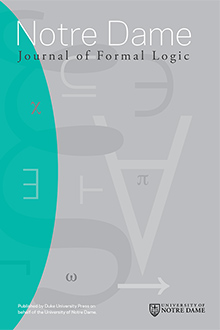Kreisel’s set-theoretic problem is the problem as to whether any logical consequence of ZFC is ensured to be true. Kreisel and Boolos both proposed an answer, taking truth to mean truth in the background set-theoretic universe. This article advocates another answer, which lies at the level of models of set theory, so that truth remains the usual semantic notion. The article is divided into three parts. It first analyzes Kreisel’s set-theoretic problem and proposes one way in which any model of set theory can be compared to a background universe and shown to contain internal models. It then defines logical consequence with respect to a model of ZFC, solves the model-scaled version of Kreisel’s set-theoretic problem, and presents various further results bearing on internal models. Finally, internal models are presented as accessible worlds, leading to an internal modal logic in which internal reflection corresponds to modal reflexivity, and resplendency corresponds to modal axiom 4.
Notre Dame J. Formal Logic
58(1):
47-78
(2017).
DOI: 10.1215/00294527-3716058
[4] Drake, F. R., Set Theory: An Introduction to Large Cardinals, vol. 76 of Studies in Logic and the Foundations of Mathematics, North-Holland, Amsterdam, 1974. MR3408725 0294.02034[4] Drake, F. R., Set Theory: An Introduction to Large Cardinals, vol. 76 of Studies in Logic and the Foundations of Mathematics, North-Holland, Amsterdam, 1974. MR3408725 0294.02034
[10] Keisler, H. J., “Fundamentals of Model Theory,” pp. 47–103 in Handbook of Mathematical Logic, Part A, edited by J. Barwise, North-Holland, Amsterdam, 1977.[10] Keisler, H. J., “Fundamentals of Model Theory,” pp. 47–103 in Handbook of Mathematical Logic, Part A, edited by J. Barwise, North-Holland, Amsterdam, 1977.
[11] Kreisel, G., “Informal rigour and completeness proofs,” pp. 78–94 in The Philosophy of Mathematics, edited by J. Hintikka, Oxford University Press, London, 1969.[11] Kreisel, G., “Informal rigour and completeness proofs,” pp. 78–94 in The Philosophy of Mathematics, edited by J. Hintikka, Oxford University Press, London, 1969.
[12] Kunen, K., Set Theory: An Introduction to Independence Proofs, Elsevier, Amsterdam, 1980. MR597342 0443.03021[12] Kunen, K., Set Theory: An Introduction to Independence Proofs, Elsevier, Amsterdam, 1980. MR597342 0443.03021
[13] Makkai, M., “Admissible sets and infinitary logic,” pp. 233–81 in Handbook of Mathematical Logic, Part A, edited by J. Barwise, North-Holland, Amsterdam, 1977.[13] Makkai, M., “Admissible sets and infinitary logic,” pp. 233–81 in Handbook of Mathematical Logic, Part A, edited by J. Barwise, North-Holland, Amsterdam, 1977.
[17] Ressayre, J.-P., “Modèles non standard et sous-systèmes remarquables de ZF,” pp. 47–147 in Modèles non standard en arithmétique et théorie des ensembles, edited by J.-P. Reyssaire and A. J. Wilkie, Publications mathématiques de l’Université Paris VII, Paris, 1983.[17] Ressayre, J.-P., “Modèles non standard et sous-systèmes remarquables de ZF,” pp. 47–147 in Modèles non standard en arithmétique et théorie des ensembles, edited by J.-P. Reyssaire and A. J. Wilkie, Publications mathématiques de l’Université Paris VII, Paris, 1983.
[20] Suzuki, Y., and G. Wilmers, “Non-standard models for set theory,” pp. 278–314 in The Proceedings of the Bertrand Russell Memorial Logic Conference (Uldum, 1971), edited by J. L. Bell, J. C. Cole, G. Priest, and A. B. Slomson, Bertrand Russell Memorial Logic Conference, University of Leeds, Leeds, 1973.[20] Suzuki, Y., and G. Wilmers, “Non-standard models for set theory,” pp. 278–314 in The Proceedings of the Bertrand Russell Memorial Logic Conference (Uldum, 1971), edited by J. L. Bell, J. C. Cole, G. Priest, and A. B. Slomson, Bertrand Russell Memorial Logic Conference, University of Leeds, Leeds, 1973.
[21] Tait, W. W., “Foundations of set theory,” pp. 273–90 in Truth in Mathematics, edited by H. G. Dales and G. Oliveri, Oxford University Press, New York, 1998.[21] Tait, W. W., “Foundations of set theory,” pp. 273–90 in Truth in Mathematics, edited by H. G. Dales and G. Oliveri, Oxford University Press, New York, 1998.





